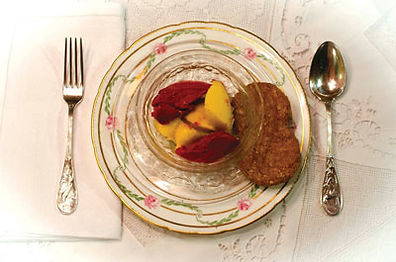
Courtesy of Samuel P Peabody

RICHARD BARKER

Thomas Lee Jones
In her mid-80s, Edith Wilmerding Montgomery was tall, thin, formidable, and blessed with an equine face that Modigliani would have loved.
“You know,” she pronounced in her clipped, impeccably patrician tones, “ I insist on finger bowls —even at luncheon. Even if it’s only my sister and me. Otherwise the maids get sloppy. They don’t like using them. Makes more work. But I insist on them.”
I silently nodded.
This was at the beginning of the 1980s and I never knew what to expect from ladies like Mrs. Montgomery who had been born in Edwardian days; I had learned just to be quiet. After all, even in the early ’80s finger bowls were, at most, a reminder of a vanished way of life.
Of course, Tiffany’s Table Manners for Teenagers, that invaluable guide for those not wishing to make fools of themselves in seriously social situations and first published in 1961, had taught me all about them:“After the meat course the table is cleared of the dinner or luncheon plates and all unused silver. The peppers and salts are also removed, and the table is crumbed.
Then the dessert plate is served...with the finger bowl, spoon, and fork on the plate.
Remove the finger bowl and place it on the table to the upper left of your plate.
Also remove the fork to the left and the spoon to the right. Do not leave the doily (if any) on your plate by mistake. It is not supposed to be eaten with your ice cream….
When it comes time to use your finger bowl, dip the tips of your fingers in it. But don’t forget, it is not a bathtub; you’re not supposed to dunk your whole hand. If you wish, you may also brush the tips of your wet fingers over your mouth….”
But today, in the early years of the 21st-century cyberworld, does anybody still use these pretty little accoutrements, much less care about their ritualized usage?
Very rarely.
Perhaps finger bowls still might show up in some exceptional circumstances, but for the most part they have gone the way of mourning stationery, white-tie opening nights, dial telephones, record players and same-sex colleges. That is to say, they are, at best, interesting anachronisms.

If during the last years of the 20th century the world was changing at breakneck speed, somehow the dawn of this new one—and even, it might be argued, the experience of 9/11—really did start an entirely new chapter. Things could hardly ever be the same; there seemed little point in trying to hold on to things which seemed to have been blown up before our eyes.
But there was a time when finger bowls—and their correct usage—were more than a lighthearted joke. They were a small part of a ritualized upper-class lifestyle that meant a great deal to the people who were part of it and often meant more to the people who aspired to join its ranks.
RICHARD BARKER
The 1937 edition of Etiquette: The Blue Book of Social Usage by Emily Post instructs readers that “the finger bowl is less than half filled with cold water; and at dinner parties a few violets, sweet peas, or occasionally a gardenia may (or may not) be put in it. A slice of lemon is never seen outside of a chophouse, where eating with the fingers may necessitate the lemon in removing grease. Pretty thought!”
The world was different then.
There seemed to be more time for niceties, more effort put into things like good penmanship, and more of a concern for social distinctions.
In 1960 social historian Cleveland Amory talked about this kind of hierarchy in his fascinating book Who Killed Society? Yes, money was certainly an integral part of accepted values but money was far from being the only thing that mattered as some complain it is now.
Amory began his book reporting on interviews he’d conducted in 1957 with Bertha Eastman Barry, the unassuming woman of humble origins who had been “for more than half a century, perhaps the most powerful single individual in that strange and mysterious force known as American Society.” Mrs. Barry, who ran the Social Register, was quoted as saying, “Mercy! Society isn’t a knit thing anymore. It’s everybody and his brother!”
True that may have been, but at least throughout much of the 20th century the “everybody and his brother” were more or less aspiring to the same standards and qualities that were perceived to exist in the real upper classes. A Mrs. Newonthescene may not have had the genealogical credentials of the Van Rensselaers or Livingstons, but she certainly made a point of upholding what she perceived as their rules.
Now it’s different—maybe not always better, maybe not always worse, but different.
Traveling around the country in the 1980s and ’90s, I got to see firsthand some of the last gasps of American Society as it had once existed. Of course in various places there were nuances of difference but there was certainly an essential sameness as well: the right schools, the right clubs, the right neighborhoods, the right churches, the right friends.
Some of it was very impressive: the wonderful houses and beautiful family heirlooms, the gracious manners, the understatedly luxurious lifestyle. If you were admitted to the inner circle, things were very comfortable indeed.
If you were not admitted, however, things could get pretty dicey: pompous and condescending at best, repressive and entirely off-limits at worst.
Lunching at the Boston Club in New Orleans, a cornerstone of that city’s old guard, I was listening to a group of longtime members wax on about the elaborate preparations for certain private Mardi Gras celebrations. Various local men’s clubs were the unmoved movers of the celebration and the membership of these clubs assembled elaborate royal courts that mimicked those of a mythical Europe in ages past. It was considered an enormous honor for a club member’s daughter to be crowned queen of one of these and it was even prestigious to be selected to be part of her court. (One now-senior New Orleanian I know still regards being chosen as a page, at about age 5, to be a highlight of his life.)
Listening to this conversation, I wondered about the enormous expenditures lavished on these extended parties that only benefited those involved and I asked, “What about the cultural and philanthropic life of the city?”
“We leave that to others” was the answer. It promptly shut me up and I could only guess who these “others” were.
No, the New Orleans old guard did not like outsiders and these outsiders more often than not were anyone who hadn’t been born right there in the city and into the right group. These requirements despite the disclosure that Mr. Amory brings up about the city’s history: “Plagued in the early days by a shortage of women, the King of France dispatched in 1721 eighty-eight women from houses of correction in Paris. For several years he continued to send ‘correction girls’ until in 1728 came the famous ‘casket girls’—a group of better class girls, albeit many were girls from orphanages, who arrived, each with a little ‘casket’ of clothing and personal effects.”
The other place which struck me as equally xenophobic was St. Louis. And interestingly enough, both of these were cities where Mardi Gras was celebrated in a very big way and where being Roman Catholic was not necessarily the negative it was in other places.
Arbitrary exclusion can be offensive and is usually boring but it was an integral part of the bigger landscape. Now it is far less so.
Declining interest has forced certain institutions to loosen up. The Veiled Prophet Ball in St. Louis (that city’s version of New Orleans’ exclusive Mardi Gras parties) is now an essentially civic event with little, if any, regard to lineage. Debutante parties everywhere are far fewer than they were even in the 1960s and those that do survive are mostly just another method of fund raising. It’s been reported (on Facebook of all places) that The Green Book in Washington, DC, which bills itself as “the preeminent list of Washington’s society and arbiter of social precedence in the Metropolitan area,” now requires buying a subscription in order to maintain a listing. The Brook Club in New York, once the most elitist and closed of its brethren, has expanded and altered its perimeters of membership substantially. The Saturn Club in Buffalo, previously a bastion of that city’s old guard, recently sent an invitation to join to a gentleman based solely on his moving into a well-regarded apartment building.
And what has all of this to do with finger bowls?
They, like the lifestyle and even the standards they epitomized, have mostly gone away.
Sometimes all these changes are sad. Like when you don’t even get a verbal “thank you” for a good turn or when you try to reach a company or shop on the telephone and are forced into an endless series of “Please press 1...Please press 3...Please hold” messages.
Sometimes these changes are all for the good, like being able to look up a prescription’s side effects or restaurant reviews on Google.
I recently asked a friend who had been repeatedly complaining about the lack of civility he witnessed in his town as well as the wretched telephone support he was receiving from his Internet provider: “Would you be willing to give up your iPad for well-behaved fellow citizens or all-around better customer service?”
“No way!” was his immediate response.
And I suspect it would be the same thing with finger bowls.
Would you be willing to give up your dishwasher and microwave in order to return to a more gracious lifestyle?
Doubtful.
As Milton Mendle, the father of an old St. Louis friend and a man who loved his finger bowls used to say, “Every age has its compensations.”
But in any case, the sweet old finger bowls that you inherited or that you bought in an impulsive moment at a house sale do survive very nicely, thank you. For dessert: the bowl for sherbet, the under-plate for cookies.
And often nobody even realizes that they’re finger bowls.

RICHARD BARKER
For dessert: the bowl for sherbert, the under-plate for cookies.
For more than 20 years, Thomas Lee Jones served as Director of Special Projects for Forbes, Inc., and in this capacity was both Editor and Publisher of the Social Register. This article first appeared in the 13th issue (July 2012) of his website, www.orangeandmagenta.com.